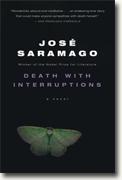Death with Interruptions
Jose Saramago
book reviews:
· general fiction
· chick lit/romance
· sci-fi/fantasy
· graphic novels
· nonfiction
· audio books
· author interviews
· children's books @
curledupkids.com
· DVD reviews @
curledupdvd.com
newsletter
win books
buy online
links
home
for authors
& publishers
for reviewers

 |
Death with Interruptions Jose Saramago Mariner Paperback 256 pages September 2009 |
|
Click here to read reviewer Damian Kelleher's take on Death with Interruptions. Everything about Death with Interruptions
The following day, no one died. This fact, being absolutely contrary to life’s rules, provoked enormous and, in the circumstances, perfectly justifiable anxiety in people’s minds, for we have only to consider that in the entire forty volumes of universal history, there is no mention, not even one exemplary case, of such a phenomenon ever having occurred, for a whole day to go by, with its generous allowance of twenty-four hours, diurnal and nocturnal, matutinal and vespertine, without one death from an illness, a fatal fall, or a successful suicide, not one, not a single one.Prolonged reading becomes something of narcotic experience; Saramago’s winding prose lulls readers into a certain complacency, allowing his satirical barbs and subtle sense of urgency to be all the more affecting. Saramago’s signature style, admittedly tedious and unnecessary at times, is chock full of asides, jokes, and barbs that illuminate what would in another writer’s hands be a bare droll social novel. For Saramago, everything is in the details, and the first half of the novel goes into plenty of it in an elaborate thought experiment based on a simple premise: what would happen if everyone stopped dying? Of course, there’s initial celebration in the streets as the human race (in one country at least) unintentionally conquers death. And then the Malthusian realization sets in: that within a few decades, most of the economy will be based on care for an ever-growing elderly population and society will be brought to a painful halt. This sets the stage for perfectly-executed (if not particularly new) satire of religious and political figures who are terrified of death’s hiatus and its loosening effect on their complementary vice grips of power. Entrenched oligarchs aren’t Saramago’s only victims: he turns an unforgiving eye to the legions of common folk who decide to profiteer off the fortunes and misfortunes of those around them. This part of the novel is devoid of specific characters. It hovers around different social and political spheres, chronicling an event more than telling a story. Its cool detachment is modernist to the core, but underneath this supposed ambivalence lies a voice that deeply cares about these people, for all their failings and shortsightedness. Saramago uses this narrative form to great effect; there are few walks of life he doesn’t touch. When he does decide to zero in on a character and grant an individual spark of life to his otherwise purely social novel, he chooses death herself (small d, please). In the second half of the novel, death writes to the major media outlets informing them that her experiment with human immortality has been a failure and people will start dying again soon. But now they’ll receive a letter informing them they have a week left to live, a courtesy call. Of sorts. When one letter keeps getting returned to sender, she stalks the man—in supernatural and human forms—who continues to evade her. Death falls in love. And after a whole novel about humanity’s inhumanity, what emerges at the end of Death with Interruptions This is not Saramago’s best offering, and longtime fans may be disappointed by the relatively limited scope and daring of Death with Interruptions Originally published on Curled Up With A Good Book at www.curledup.com. © Max Falkowitz, 2010 |
| Also by Jose Saramago: |
|
|
|
 Click here to learn more about this month's sponsor! |
|
| fiction · sf/f · comic books · nonfiction · audio newsletter · free book contest · buy books online review index · links · · authors & publishers reviewers |
|
| site by ELBO Computing Resources, Inc. | |
 For the uninitiated, all descriptions of Saramago’s writing do it no justice. Here are the first two sentences of the novel:
For the uninitiated, all descriptions of Saramago’s writing do it no justice. Here are the first two sentences of the novel: